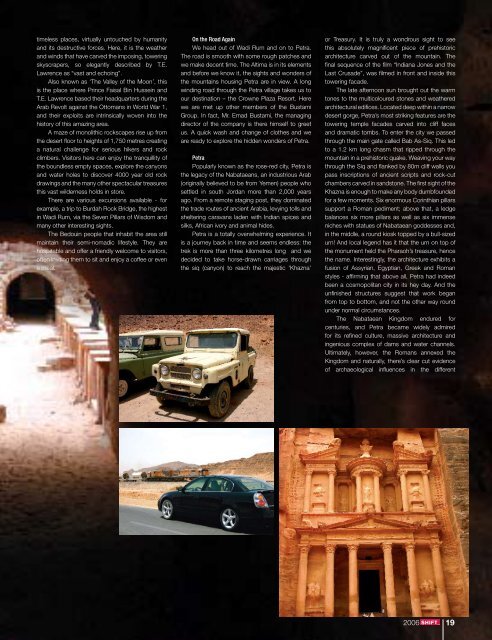Create successful ePaper yourself
Turn your PDF publications into a flip-book with our unique Google optimized e-Paper software.
timeless places, virtually untouched by humanity<br />
and its destructive forces. Here, it is the weather<br />
and winds that have carved the imposing, towering<br />
skyscrapers, so elegantly described by T.E.<br />
Lawrence as “vast and echoing”.<br />
Also known as ‘The Valley of the Moon’, this<br />
is the place where Prince Faisal Bin Hussein and<br />
T.E. Lawrence based their headquarters during the<br />
Arab Revolt against the Ottomans in World War 1,<br />
and their exploits are intrinsically woven into the<br />
history of this amazing area.<br />
A maze of monolithic rockscapes rise up from<br />
the desert floor to heights of 1,750 metres creating<br />
a natural challenge for serious hikers and rock<br />
climbers. Visitors here can enjoy the tranquillity of<br />
the boundless empty spaces, explore the canyons<br />
and water holes to discover 4000 year old rock<br />
drawings and the many other spectacular treasures<br />
this vast wilderness holds in store.<br />
There are various excursions available - for<br />
example, a trip to Burdah Rock Bridge, the highest<br />
in Wadi Rum, via the Seven Pillars of Wisdom and<br />
many other interesting sights.<br />
The Bedouin people that inhabit the area still<br />
maintain their semi-nomadic lifestyle. They are<br />
hospitable and offer a friendly welcome to visitors,<br />
often inviting them to sit and enjoy a coffee or even<br />
a meal.<br />
On the Road Again<br />
We head out of Wadi Rum and on to Petra.<br />
The road is smooth with some rough patches and<br />
we make decent time. The Altima is in its elements<br />
and before we know it, the sights and wonders of<br />
the mountains housing Petra are in view. A long<br />
winding road through the Petra village takes us to<br />
our destination – the Crowne Plaza Resort. Here<br />
we are met up other members of the Bustami<br />
Group. In fact, Mr. Emad Bustami, the managing<br />
director of the company is there himself to greet<br />
us. A quick wash and change of clothes and we<br />
are ready to explore the hidden wonders of Petra.<br />
Petra<br />
Popularly known as the rose-red city, Petra is<br />
the legacy of the Nabataeans, an industrious Arab<br />
(originally believed to be from Yemen) people who<br />
settled in south Jordan more than 2,000 years<br />
ago. From a remote staging post, they dominated<br />
the trade routes of ancient Arabia, levying tolls and<br />
sheltering caravans laden with Indian spices and<br />
silks, African ivory and animal hides.<br />
Petra is a totally overwhelming experience. It<br />
is a journey back in time and seems endless: the<br />
trek is more than three kilometres long and we<br />
decided to take horse-drawn carriages through<br />
the siq (canyon) to reach the majestic ‘Khazna’<br />
or Treasury. It is truly a wondrous sight to see<br />
this absolutely magnificent piece of prehistoric<br />
architecture carved out of the mountain. The<br />
final sequence of the film “Indiana Jones and the<br />
Last Crusade”, was filmed in front and inside this<br />
towering facade.<br />
The late afternoon sun brought out the warm<br />
tones to the multicoloured stones and weathered<br />
architectural edifices. Located deep within a narrow<br />
desert gorge, Petra’s most striking features are the<br />
towering temple facades carved into cliff faces<br />
and dramatic tombs. To enter the city we passed<br />
through the main gate called Bab As-Siq. This led<br />
to a 1.2 km long chasm that ripped through the<br />
mountain in a prehistoric quake. Weaving your way<br />
through the Siq and flanked by 80m cliff walls you<br />
pass inscriptions of ancient scripts and rock-cut<br />
chambers carved in sandstone. The first sight of the<br />
Khazna is enough to make any body dumbfounded<br />
for a few moments. Six enormous Corinthian pillars<br />
support a Roman pediment; above that, a ledge<br />
balances six more pillars as well as six immense<br />
niches with statues of Nabataean goddesses and,<br />
in the middle, a round kiosk topped by a bull-sized<br />
urn! And local <strong>legend</strong> has it that the urn on top of<br />
the monument held the Pharaoh’s treasure, hence<br />
the name. Interestingly, the architecture exhibits a<br />
fusion of Assyrian, Egyptian, Greek and Roman<br />
styles - affirming that above all, Petra had indeed<br />
been a cosmopolitan city in its hey day. And the<br />
unfinished structures suggest that work began<br />
from top to bottom, and not the other way round<br />
under normal circumstances.<br />
The Nabataean Kingdom endured for<br />
centuries, and Petra became widely admired<br />
for its refined culture, massive architecture and<br />
ingenious complex of dams and water channels.<br />
Ultimately, however, the Romans annexed the<br />
Kingdom and naturally, there’s clear cut evidence<br />
of archaeological influences in the different<br />
2006 19


